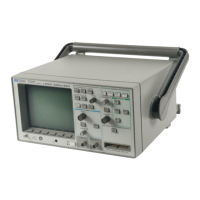All numbers are expected to be strings of ASCII characters. Thus, when
sending the number 9, you would send a byte representing the ASCII code for
the character “9” (which is 57). A three-digit number like 102 would take up
three bytes (ASCII codes 49, 48, and 50). This is taken care of automatically
when you include the entire instruction in a string.
Embedded Strings
Embedded strings contain groups of alphanumeric characters which are
treated as a unit of data by the logic analyzer. For example, this line of text
written to the advisory line of the instrument with the :SYSTem:DSP
command is an embedded string:
:SYSTEM:DSP"This is a message."
Embedded strings may be delimited with either single (’) or double (")
quotation marks. These strings are case-sensitive, and spaces act as legal
characters—just like any other character.
Introduction to Programming
Program data syntax rules
19

